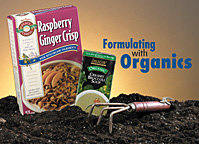
According to a survey of the manufacturer members of the OTA, the fastest-growing organic categories between 1999 and 2000 were soyfoods and other meat/dairy alternatives, meat and poultry and eggs, miscellaneous canned and jarred products, and dairy. Individual projected growth rates for 2000 to 2001 are: soyfoods and other meat/dairy alternatives (94% growth), fiber (53% growth), meat and poultry and eggs (59% growth), miscellaneous canned and jarred products (45% growth), and dairy (41% growth).
New organic standards and labeling rules will add to the appeal of these organic products. Standards will assure consumers that the word “organic” on U.S. products means that the ingredients and production methods have been verified by an accredited certification agency as meeting or exceeding USDA standards for organic production. The new organic standards detail the methods, practices and substances that can be used in producing and handling organic crops and livestock, as well as processed products. They also establish clear organic labeling criteria (see sidebar) and prohibit the use of genetic engineering methods, ionizing radiation, and sewage sludge for fertilization.
Having national standards clarifies what can be called an organic product in the marketplace. The challenges for those formulating organic foods are sourcing certified ingredients and knowing what ingredients can and cannot be used in organic products.
The National List
A primary source of information on acceptable ingredients is the National List (www.ams.usda.gov/nop/nop2000/ Final%20Rule/regtext/reg-natlist.htm). Congress mandated this list of materials as part of the Organic Foods Production Act of 1990 (OFPA). Its purpose is to make clear which materials can and cannot be used in organic production, processing and handling in the U.S.The National List is divided into three parts: 1.) Acceptable synthetic production materials; 2.) Prohibited natural production materials; 3.) Acceptable non-agricultural, non-synthetic processing aids. These lists contain the exceptions to the understanding within the organic industry “that all organically grown and handled foods are produced with solely natural materials.”
Following is a sample of ingredients that the National List allows the use of in or on processed products labeled as “organic” or “made with organic (specified ingredients or food groups(s)).”
- Citric acid—produced by microbial fermentation of carbohydrate substances
- Colors—nonsynthetic sources only
- Dairy cultures
- Flavors—nonsynthetic sources only and must not be produced using synthetic solvents and carrier systems or any artificial preservative
- Enzymes—must be derived from edible, nontoxic plants, nonpathogenic fungi or nonpathogenic bacteria
- Tocopherols—derived from vegetable oil when rosemary extracts are not a suitable alternative
- Xanthan gum
- Gums—water-extracted only (arabic, guar, locust bean, carob bean)
- Kelp—for use only as a thickener and dietary supplement
- Lecithin—unbleached
As always, such issues are not black and white. For example, “Is an organic corn starch that does not possess a needed functionality in a formula a viable alternative to a non-organic corn starch that does possess the required functionality?” asks Joe Lombardi, marketing manager, National Starch and Chemical, Bridgewater, N.J.
What does “commercially available” mean? Is it someone in China who provides a few thousand pounds of an organic ingredient costing $10/lb. to transport it to the U.S., or is it someone who can reliably supply the industry at a reasonable cost? “No one seems to have a one-size-fits-all answer. There is ongoing debate on the issue. This is necessary and good for the growth and health of the industry,” notes Lombardi.

Organic Challenges
The National List and other sources, such as the Organic Material Review Institute (OMRI), aid food manufacturers in deciphering what is and is not allowed in organic foods. There are some ingredient categories, however, that pose formulation challenges for formulators. Some ingredients are not acceptable, unavailable or difficult to source, while others stir controversy when used in organic products. Here are some of the more prominent categories.-
Various preservative-type additives. These include sulfites, nitrates or nitrites, and any ingredient known to contain higher levels of heavy metals or toxic residues than permitted by federal regulation.
- Value-added or further processed organic ingredients. “Processed ingredients, in general, are difficult to source. There are only a couple of classes of organic flavors available—primarily essential oils and reaction-type culinary flavors,” observes Mulry.
- Non-GMO ingredients. These ingredients are always difficult to source. For example, non-GMO citric acid has to be sourced from European plants to assure identity preservation, says Mulry.
-
Starches. Starch ingredients with additional functionality would be desirable for organic products, adds Mulry. However, food manufacturers have become more adept at using what is available. There is not just organic cornstarch, but also potato, rice and other starches that may give different functionality in organic form.
-
Colors. Colors must be derived from natural sources, which due to stability, makes them difficult to use in some formulations. Achieving specific hues is also difficult with natural colors.
- Added nutrient vitamins and minerals. “The use of added nutrient vitamins and minerals is typically not allowed by most regulatory bodies, unless specifically required by law (for enrichment of breads and cereals, for example),” states Mulry. Organic orange juice and soymilk are two products that are available in fortified forms, but not required by law. “The Final USDA Rule, effective in October 2002, is potentially more restrictive and could have a significant impact on the availability of these types of products in the U.S.”
“There is a dichotomy in the organic industry,” opines Lombardi. Some see any deviation from the most conservative interpretation of the organic rule as sacrificing their soul. Others want to see organic products become more acceptable to mainstream consumers, who have demands in regards to cost and sensory criteria for products. Many ingredients lie in a gray area where they don't quite conform to strict organic standards, but meet the philosophy of organic—minimal processing, all natural, healthful, etc.
Debates over such volatile issues are truly the sign of a vital industry.

Sidebar: Organic Labeling
By the fall of 2002, consumers will see new organic labeling on products in their local grocery stores. The new national organic standards allow four labeling options.- 100% Organic. Only products that have been exclusively produced using organic methods will be allowed to carry a “100% organic label.”
-
Organic. This will signify that 95% of the ingredients (by weight, excluding water and salt) in a processed product have been organically produced. The remaining five percent can only be natural ingredients or synthetic ingredients that are allowed on the National List. Organic products must be processed by a certified organic handler.
-
Made with Organic. Products with 70 to 95% organic ingredients may display “Made with organic [with the specific ingredient or ingredients listed]” on the front panel. Organic products must be processed by a certified organic handler.
- Products with less than 70% organic ingredients would be allowed to list the organic items in the ingredient panel only.